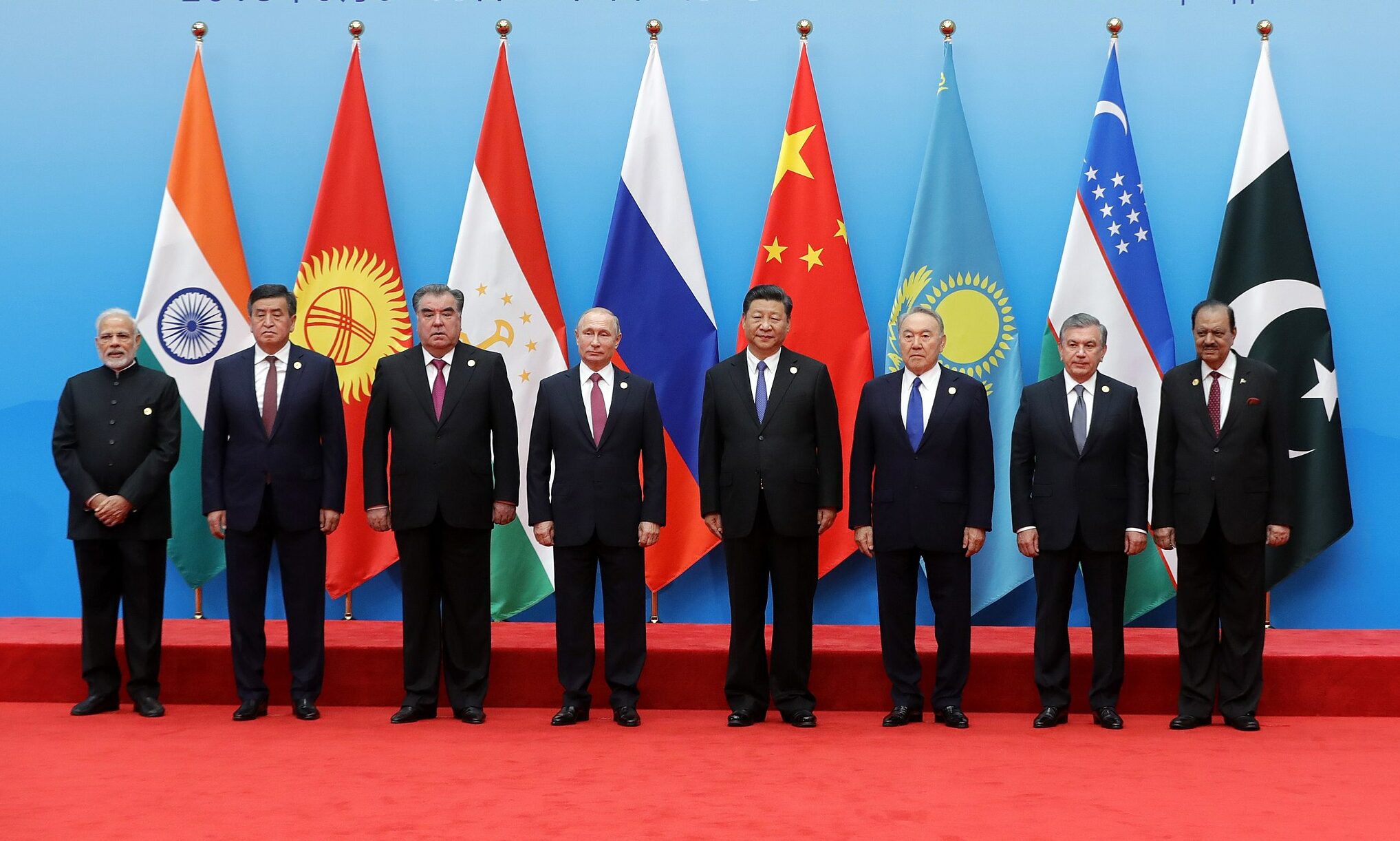Expanding Chinese Multilateralism in Central Asia

Russia’s multilateralism in Central Asia is showing signs of unraveling. Amid cracks in Russia-led regional groupings, China has now much bigger space to advance its own initiatives.
As Russia’s unsuccessful war in Ukraine drags on, the effects of Moscow’s defeats are reverberating far and deep across Eurasia. Central Asia, the region traditionally viewed by Moscow as a sphere of its exclusive influence, is now experiencing geopolitical trends which bode ill for the Russian position there.
Flailing Russia
One of the elements, and arguably the most potent tool Russia employed to influence the region, was the Collective Security Treaty Organization (CSTO). This was part of Moscow’s efforts to manage Central Asia through numerous multilateral initiatives carefully constraining the maneuverability of the region’s states as well as keeping outside players at bay.
The membership of Kazakhstan, Kyrgyzstan, and Tajikistan, three out of five Central Asian states, in the CSTO further cemented Russia’s position as the major security guarantor and helped develop an unofficial “division of labor” with China. While Russia focused on security issues, China was mostly seen as the economic powerhouse in the region. The comfort both sides found in this relationship was evidenced by few, if any, public disagreements between the countries, leading Moscow and Beijing to proclaim a “no limits” partnership in February 2022.
Yet, the unofficial arrangement comes under increasing duress reflected in the weakening of the CSTO and other Russian initiatives in Central Asia. In mid-September, when Shanghai Cooperation Organization (SCO) summit was held in Samarkand, Uzbekistan, deadly clashes took place on the Kyrgyzstan-Tajikistan border. The hostilities were initiated by the Tajik side, leading to up to a hundred deaths and tens of thousands of displaced. The escalation was especially embarrassing for the Russian leadership as the Russian president, Vladimir Putin, was present at the summit together with his Tajik and Kyrgyz colleagues, members of the CSTO. No proper reaction followed from the grouping after the Kyrgyz side sent a note of protest.
Russia is now blamed for CSTO’s inaction, which undermines Moscow’s multilateral obligations. Moscow’s unreliability as an ally cuts at the foundation of Russian multilateralism in the region. On October 9, Kyrgyzstan refused to host military exercises called “Indestructible Brotherhood-2022” which was scheduled for mid-October. Bishkek also did not take part in exercises planned to be held in Tajikistan. Moreover, Kyrgyz leader Sadyr Japarov abstained from traveling to Russia for a summit of the Commonwealth of Independent States (CIS), another multilateral body led by Moscow since the end of the Soviet Union.
It is not just CSTO that is having a problem. Russia’s Eurasian Economic Union (EEU) also seems on its back foot. With emerging troubles in bilateral relations with Kazakhstan and Kyrgyzstan, bilateral trade, connectivity, and even cooperation in such areas as cyber security is coming under strain. Clearly, the belief in economic prosperity through cooperation with Russia is waning in the region.
Advancing Chinese Multilateralism
For China, Russia’s weakening security position provides wider space for active involvement in Central Asia. Built upon its earlier moves such as the opening of military and semi-military bases in Tajikistan, the Central Asian states’ disillusion with Russia could push Beijing to assume a more proactive role in the security sphere as well. The scope of military cooperation (military exercises, transfer of military equipment) with Central Asia states has been steadily increasing over the last decade. Hints of the potential presence of Chinese private military companies in the region are also spreading.
This does not mean that China will be taking an openly negative stance toward the CSTO. It simply cannot afford to do that, as three members of the grouping are China’s close partners in the region. Indeed, outwardly, all will remain the same. Beijing will champion cooperation with CSTO as in June when China’s top legislator Li Zhanshu argued that Beijing planned to strengthen exchanges and cooperation with the Russia-led military alliance to “take effective measures to jointly maintain regional peace and stability.” It is thus no wonder that Beijing had a muted reaction to Russia sending CSTO troops to Kazakhstan in early January 2022 to help quell the internal unrest.
Yet, amid the continuing war in Ukraine and Russia’s palpable inability to act as a responsible actor in relations with its smaller allies, China will be taking note of the growing vacuum.
Surely, China is not necessarily happy to see Russia as a too-weakened power on the global stage. As a close geopolitical partner that is a close ally in confronting the US-led West, Beijing does not want Russia to emerge from its war badly defeated. That would send a dangerous signal to Beijing that the collective West is strong and able to counter potential military adventurism.
But when it comes to Central Asia, China wants to see a more retracted Russia. And a westward push towards the region remains a highly prioritized foreign policy direction in China. Moreover, Beijing understands that despite the highly successful transactional approach it has used with all Central Asia states, advancing multilateral cooperation will be more long-term in essence.
Indeed, just after Xi Jinping’s visit to Kazakhstan, first-ever visit of the Chinese leader abroad after the pandemic, Chinese Vice President Wang Qishan attended the 6th summit of the Conference on Interaction and Confidence-Building Measures in Asia (CICA) held in Astana. Amid the war in Ukraine and China’s push for a new security vision as exemplified by the Global Security Initiative, Beijing is now paying particular attention to forums such as CICA. Another multi-country initiative spearheaded by China is the long-stalled China-Kyrgyzstan-Uzbekistan project. China has successfully taken advantage of Russia’s being distracted and its momentary weakness to finally make progress on the project.
China is also pushing for greater multilateral cooperation through a relatively new platform gathering China and the five Central Asian states where annual summit meetings were initiated in 2020. In June, China’s Foreign Minister Wang Yi took part in the third “China+Central Asia” (C+C5) foreign ministers’ meeting in Astana.
Chinese efforts have not gone unnoticed by Russia, which is becoming worried about losing its clout in the region. Moscow convened its own summit with Central Asian states in mid-October. Yet even there, Russian weakness was on display when the Tajik president put Putin in a difficult spot by accusing Moscow of treating Central Asian states disrespectfully.
Yet, arguably the most important multilateral initiative promoted by China in the region is SCO. Though Russia tries to portray it primarily as an anti-Western grouping, for China, SCO is more about cementing its position in Central Asia. The states in the region readily embrace Chinese initiative as it widens the scope of cooperation and, crucially, helps to balance Russia.
Chinese multilateralism in Central Asia might be less about defined rules and treaties. Its fluidity and looseness however could constitute a major strength amid flagging Russian influence. To be sure, Moscow will not be abandoning its positions easily, but the existing trend is well visible – fewer countries in the region regard Russia as a reliable partner. At the same time, Central Asian states will seek to avoid overdependence on China as well. What they want instead is greater maneuverability. Beijing and its multilateral initiatives present a powerful instrument to achieve that goal.
Written by
Emil Avdaliani
emilavdalianiEmil Avdaliani is a research fellow at the Turan Research Center and a professor of international relations at the European University in Tbilisi, Georgia. His research focuses on the history of the Silk Roads and the interests of great powers in the Middle East and the Caucasus.


